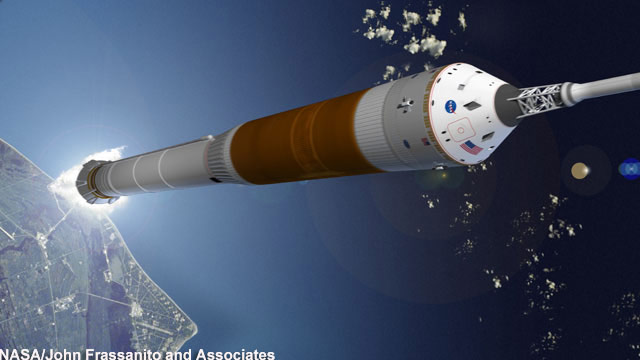NASA Shifts Tech Focus to CEV, Crewed Moon Missions

NASA's investment in enabling technologies for spaceexploration has been scaled back dramatically in the past year and focused onareas deemed critical to fielding the Crew ExplorationVehicle (CEV) and conducting the firsthuman lunar sorties since the Apollo program.
The $1 billion worth of human and robotic technologyprojects NASA's Exploration Systems Mission Directorate selected in late 2004would have kept scores of researchers in industry and academia busy for yearsworking on a mix of pressing problems and longer-range considerations facing aspace agency daring to venture beyond Earth's orbit.
NASA Administrator Mike Griffin, sworn in several monthsafter the selections were made by the previous NASA regime, did not waste muchtime deciding that the agency could not afford such a robusttechnology-development portfolio if it wanted to keep its exploration agenda ontrack.
"The old portfolio included 118 separate projectsvalued at around $1 billion annually," said Chris Moore, the NASA programexecutive managing the agency's downsized exploration-technology-developmentportfolio. "Griffin quickly decided that NASA could not afford thatapproach and cut the effort back significantly."
In the 10 months since Griffin first put industry on noticethat the exploration-technology portfolio would be pared back, 80 of the 118originally selected projects have been canceled. The 38 projects remaining,Moore said, would be seen through to at least the end of their initial one-yearphase.
Moore said NASA also has set up roughly two dozen newprojects led by NASA field centers to develop technologies deemed highpriorities by the ExplorationSystem Architecture Study the agency commissioned last year to chart itscourse back to the Moon.
Among the key technology needs the study identified were ablativeheat shields for the CEV, lightweight fuel tanks, radiationshielding, electronics able to function in extreme environments andtechniques for producingoxygen from the lunar regolith, to name just a few.
Breaking space news, the latest updates on rocket launches, skywatching events and more!
Moore said NASA's regional field centers will be leading thetechnology-development efforts, an approach, he said, that is consistent withGriffin's plan to involve all of its centers in the agency's explorationprogram.
"Before we had competed everything in the program andthe centers had to propose along with industry and the universities,"Moore said. "Under this approach we are assigning centers to leadparticular technology areas and then give them authority to solicit theprojects that would support technology development in that area. We are tryingto maintain healthy work forces at the centers."
With an anticipated annual budget of roughly $300 million,the new field center-led effort is intended to see promising explorationtechnologies through to prototype-level demonstrations in a relevantenvironment - what NASA refers to as Technology Readiness Level 6.
At that point, Moore said, the technologies are consideredmature enough to be adopted by NASA's Constellation Program for inclusion inthe CEV, launchersand other systems needed to reach the Moon and operate on the surface forincreasingly extended periods.
"We've phased the program so that we are working ontechnologies needed right way for the CEV and [Crew Launch Vehicle] and also onlong-lead technologies we are going to need to support the lunar outpost, likein-situ resource utilization," Moore said.
The biggest of the new field center-led technology projects,according to Moore, has been given to Ames Research Center. The Mountain View,Calif.-based field center has been put in charge of a three-year project toevaluate candidate materials for the CEV's ablative heat shields and producinga prototype ready for testing in 2007 or 2008.
The next two biggest efforts in Moore's portfolio are beingled by Glenn Research Center in Cleveland. Glenn has awarded several contractsto industry to help develop so-called green propulsion systems that could beused in place of highly reliable but highly toxic hydrazine-powered systems onthe lunarlander and elements of NASA's exploration architecture. Glenn also isworking to develop non-toxic auxiliary power units for the CEV.
So far, four other NASA field centers have been brought intothe mix to manage some of the new efforts as well as the 38 competed projectsthat escaped Griffin's budget ax.
Some of the competed projects that remain funded includework on lightweight fuel tanks, radiation-hardened electronics and lightweightpower storage devices.
Leora Peltz, a scientist at Boeing Phantom Works inHuntington Beach, Calif., is working with the Georgia Institute of Technologyin Atlanta on robust electronic components that can survive the Moon'sradiation environment and dramatic temperature swings. Peltz and hercolleagues' work on silicon germanium integrated electronics for extremeenvironments remains funded at least through this year.
If NASA continues the project through to completion, Peltzsaid she and her colleagues would produce prototype components ready to provetheir worth in thermal vacuum chambers and bombarded with radiation.
Larry Clark, manager of spacecraft technology development atLockheed Martin Space Systems in Denver, has two competed projects that remainfunded for now, albeit at substantially reduced levels. Clark and his team areworking on a process for makingoxygen from the lunar soil and a regenerativefuel cell system that could substantially reduce the number of batteriesNASA would have to carry on a human mission to the Moon.
NASA originally planned to spend $38 million on the oxygen-productiontechnology, but Clark said the funding has been severely reduced. The sameholds true for the regenerative fuel cell project, which was selected as a $15million undertaking, but is now funded at a "caretaker level,"according to Clark.
Smaller companies also picked up some of the originalcompeted projects and remain funded today. For example, XCORAerospace of Mojave, Calif., remains hard at work on a lightweightcomposite liquid-oxygen fuel tank.
Brian Berger is the Editor-in-Chief of SpaceNews, a bi-weekly space industry news magazine, and SpaceNews.com. He joined SpaceNews covering NASA in 1998 and was named Senior Staff Writer in 2004 before becoming Deputy Editor in 2008. Brian's reporting on NASA's 2003 Columbia space shuttle accident and received the Communications Award from the National Space Club Huntsville Chapter in 2019. Brian received a bachelor's degree in magazine production and editing from Ohio University's E.W. Scripps School of Journalism.
